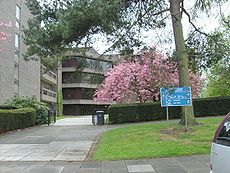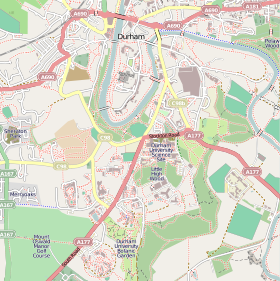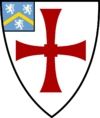- Durham University Library
-
Coordinates: 54°46′5″N 1°34′24″W / 54.76806°N 1.57333°W
Durham University Library 
Country United Kingdom Type University Library Established 1833 Location Durham, England Branches 4 (Excluding the College Libraries) Collection Items collected Books, journals, newspapers, magazines, sound and music recordings, patents, databases, maps, Parliamentary papers, Mediaeval Seals, European Union Papers, Ecclesiastical Records, Middle East Papers, drawings and manuscripts Size >1,500,000 printed items, 10,000 e-journals and more than 270,000 e-books. (Excluding the College Libraries). Access and use Access requirements Open to all students of Durham
Students from Universities within the SCONUL Vacation Access Scheme.
NHS Staff (Northern Region).
Certain external borrowers, alumi and fee-payers.Other information Director Mr Jon Purcell Website dur.ac.uk/library The Durham University Library is the centrally-administered library of Durham University in England. It was founded in January 1833 at Palace Green by a 160 volume donation by the then Bishop of Durham, William Van Mildert and now holds over 1.5 million printed items.[1] The University Library comprises four separate libraries:
- Main Library
- Education Library
- Palace Green Library
- Queen's Campus Library
Contents
History
Cosin's Library
After the donation by Bishop William Van Mildert, a suitable location to house the library's stock had to be founded and thus a gallery had to be constructed onto the Cosin's Library (a Diocesan library founded in 1669 by Bishop John Cosin located on Palace Green) in 1834. The original Cosin's library is still located at Palace Green and along with its collection of medieval manuscripts and early printed books became under the trusteeship of the University Library in 1937.
Cosin's Library is a grade one listed building and is located in an UNESCO World Heritage Site. The internal architecture and decoration are also of international importance. The original portrait panels located above the bookshelves were painted by Jan Baptist van Eerssell in 1668-9, further portraits hang in the library including half portraits of English statesmen. Nearly three hundred years later a former University Librarian, David Ramage, completed Cosin's original plan for the library by painting further portrait panels for the smaller room added in 1670-71.
In October 2005, the Museums, Libraries and Archives Council designated the collections in Cosin's Library as having an "outstanding national and international significance".
Additional bequeathed or donated collections during the 1850s (most notably by Dr Martin Joseph Routh in 1854, Bishop Edward Maltby in 1856 and Dr Thomas Mastermann Winterbottom in 1859) led to a further expansion of the library, with the upper two floors of the Exchequer Building (former Bishoprick Law Courts from 1450) being occupied. As the library's stock further expanded more space was gradually needed with a nineteenth-century lecture block eventually becoming part of the Library, and an extension to the Palace Green Library in 1966 being needed to provided a reading room and a new space for the University Library.
Recent History
The University Library has undergone many developments since the 1980s, with the first online circulation system being introduced in 1983, the Main Library won a SCONUL Library Design Award in 1988 and the online cataloguing of the library's stock beginning in 1990. In 1996 the Durham University Library also joined the Consortium of Research Libraries in the British Isles (now Research Libraries UK).
In the succeeding years the University Library was expanded further with an extension of the main library in 1997 and also became the first library in 1998 to incorporate non-Roman scripts into its electronic catalogue system. Further in 2004, the Durham Cathedral Library became part of the University Library's management system for circulation and lending.
List of past Librarians
- 1832-1834 - The Revd Patrick George
- 1834-1855 - The Revd Charles Thomas Whitley
- 1856-1858 - The Revd Robert Healey Blakey
- 1858-1864 - The Revd Henry Frederick Long
- 1865-1868 - The Revd Francis Frederick Walrond
- 1869-1873 - The Revd Thomas Forster Dodd
- 1873-1901 - The Revd Joseph Thomas Fowler
- 1901-1934 - Mr. Edward Vazeille Stocks
- 1934-1945 - Mr. Henry Waldo Acomb
- 1940-1943 - Miss Beatrice Thompson (Acting Librarian)
- 1945-1967 - Mr. David Goudie Ramage
- 1967-1989 - Miss Agnes Maxwell McAulay
- 1989-2009 - Dr John Tristan Dalton Hall
- 2009–Present - Mr. Jon Purcell
Heritage, Research and Special Collections
As part of its collection, the library contains a wealth of printed and manuscript material with a particular wealth of material from the medieval period and the Middle East along with materials from the North East. These include:
- Middle East and Islamic Studies collections: One of the most important collections in the UK, it contains over 50,000 monographs and over 2,500 periodicals covering the Ottoman Empire to ancient Mesopotamian archaeology to modern Persian literature.
- The Sudan Archive: Set up in 1957 by a former lecturer contains private papers of British subjects living in Sudan during the Anglo-Egyptian Condomunium and the papers of Abbas Hilmi II, Khedive of Egypt 1892-1914. In 2005 the collection was accorded with designated status by the Museums, Libraries and Archives Council.
- Bamburgh Library Collection: Created in 1958, the collection holds some 8,500 manuscript and print titles, with 16 incunabula across a variety of subject areas. The collection was largely acquired during the mid-seventeenth and mid-eighteenth centuries by the Archbishop of York, John Sharp (1644–1714) along with three generations of the Sharp Family. The collection contains the 1533 edition of the Psalms from Freiburg and Joannes Guinterius's Anatomicarum institutionum libri.[2][3]
- Bibliotheca Episcopalis Dunelmensis (Cosin Collection): Founded in 1669 by the then Bishop John Cosin. The collection contains over 5,000 titles, including 9 incunabula, over 600 foreign 16th-century titles. The collection is largely in French or German and based on theological issues such as Canon law and liturgy. The collection contains Cosin's 1568 Zürich edition of Heinrich Bullinger's De origine erroris.[2][4]
- Howard Collection: Contains the library of Lord William Howard of Naworth. The collection is largely of Roman Catholic texts including a Vienna imprint of Stanislaus Hosius's Confessio catholicae fidei christiana of 1561.[5]
- Quakerism Collection: Acquired in 1972 from the surviving collection of the Sunderland Preparative Meeting of the Society of Friends Library and contains approx. 880 printed volumes and a number of related manuscripts.[2]
- Kellett Collection: Principally composed of the library of Dr C. E. de M. Kellett, focusing on medicine and medical teaching. The collection contains a number of pre-18th century along with 16th and 17th century works, including Aristotle's Totius naturalis philosophiae Aristotelis paraphrases and Galen's De sanitate tuenda alongside Vidius's Chirurgia and Estienne's De Dissectione.[2][6]
- Routh Collection: Is the library of Martin Joseph Routh, President of Magdalen College, Oxford. The collection is in two sections the first on early Church Fathers entitled Reliquiae sacrae and his edition of Gilbert Burnet's History of his own time. Of the incunabula one of the most notable is Breydenbach's Itinerarium in terram sanctam. The collection contains a wealth of dating from the 14th century.[2][7]
- St Chad's Collection: Deposited by St Chad's College, Durham contains a number of 16th and 17th century imprints including Quintus Aurelius Symmachus's Epistolae familiares and the Concilia omnia.[2]
- Basil Bunting Poetry Archive: Acquired in 1987 with grants from the National Heritage Memorial Fund and the Purchase Grant Fund. It is the most extensive collection in the UK of the work of Basil Bunting (1900–1985) and of material relating to him.
- Pratt Green Collection: Is a collection founded in 1987 and contains an extensive aray of hymns and hymnology. The collection was with a gift from the Pratt Green Trustees and contains work from the distinguished hymn writer, The Reverend Dr Fred Pratt Green.[8]
- Malcolm MacDonald Papers: Papers covering the life of the former politician and Chancellor of the University.
- Earl Grey Collection: Contains extensive works and papers of the former Prime Minister.
- Durham University Observatory Records: Contains the second longest meteorological record in the UK from 1839–1953, also contains records of other local observatories.
- Medieval Seals: The collection contains many Royal and ecclesiastic devices including Duncan I king of Scots, Henry III king of England, first great seal and the seal of Pope Martin IV.
Partnerships
The University Library is a member of several organisation, including:
- Research Libraries UK
- The Association of European Research Libraries
- The Middle East Libraries Committee (UK)
- The North East Museums Libraries and Archives Council
- Research Libraries Group
- Society of College, National and University Libraries
See also
References
- ^ University Library : Library History - Durham University
- ^ a b c d e f Fabian-Handbuch: Durham University Library
- ^ Bamburgh Collection
- ^ http://www.dur.ac.uk/library/asc/printed/cosin.htm/ Bishop Cosin's Collection
- ^ http://www.dur.ac.uk/library/asc/printed/howard.htm/ Howard Collection
- ^ http://www.dur.ac.uk/library/asc/printed/kellett.htm/ Kellett Collection
- ^ http://www.dur.ac.uk/library/asc/printed/routh.htm/ Routh Collection
- ^ http://www.dur.ac.uk/library/asc/printed/pratt.htm/ Pratt Green Collection
External links
Categories:- Durham University
- Academic libraries in England
- Libraries in County Durham
- 1833 establishments in England
- Grade I listed buildings in County Durham
Wikimedia Foundation. 2010.



